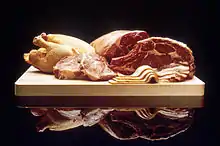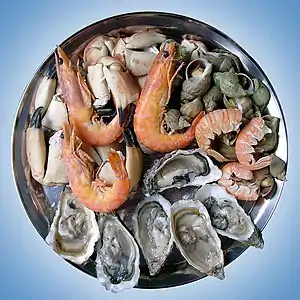Steak tartare
Steak tartare is a meat dish made from raw ground (minced) beef[1][2] or horse meat.[3] It is usually served with onions, capers, pepper, Worcestershire sauce, and other seasonings, often presented to the diner separately, to be added for taste. It is often served with a raw egg yolk on top of the dish.
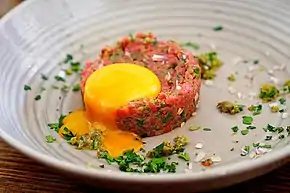 Beef steak tartare with raw egg yolk | |
| Course | Appetizer |
|---|---|
| Main ingredients | Raw beef |
| Variations | Tartare aller-retour |
| Part of a series on |
| Steak |
|---|
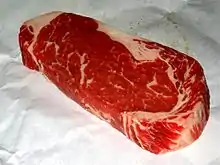 |
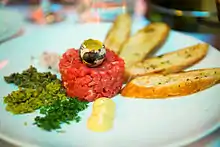
The name tartare is sometimes generalized to other raw meat or fish dishes.
A less-common version in France is tartare aller-retour, a mound of mostly raw ground meat that is lightly seared on both sides.
History
The Tatars and raw meat
A popular caricature of Mongol warriors—called Tatars or Tartars—has them tenderizing meat under their saddles, then eating it raw. This story was popularized by Jean de Joinville in the 13th century.[4] But Joinville never encountered Mongols himself and used this as a way of showing that they were uncivilized.[5] It is possible that this story was a confusion originating in the use of thin slices of meat to protect saddle sores from further rubbing.[6]
Popularization of raw meat in Europe and the United States
In the late 19th century, the Hamburg steak became popular on the menus of many restaurants in the port of New York. This kind of fillet was beef minced by hand, lightly salted and often smoked, and usually served raw in a dish along with onions and bread crumbs.[7][8] Hamburg steak gained popularity because of its ease of preparation and decreasing cost. This is evident from its detailed description in some of the most popular cookbooks of the day.[9] Documents show that this preparation style was used by 1887 in some U.S. restaurants and was also used for feeding patients in hospitals; the Hamburg steak was served raw or lightly cooked and was accompanied by a raw egg.[10]
It is not known when the first restaurant recipe for steak tartare appeared.[11] While not providing a clear name, it's possible that the dish was popularized in Paris by restaurateurs who misunderstood Jules Verne's description of "Koulbat" ("...a patty of crushed meat and eggs...") in his 1875 novel Michael Strogoff.[12]
Origins of the name
In the early twentieth century, what is now generally known as "steak tartare", was in Europe called steack à l'Americaine. One variation on that dish included serving it with tartar sauce; the 1921 edition of Escoffier's Le Guide Culinaire defines "Steack à la tartare" as steack à l'Americaine made without egg yolk, served with tartar sauce on the side. "Steack à la tartare" (literally meaning "served with tartar sauce") was later shorted to "steak tartare"[13][14] Over time, the distinction between steack à l'Americaine and its tartar-sauce variant disappeared. The 1938 edition of Larousse Gastronomique describes steak tartare as raw ground beef served with a raw egg yolk, without any mention of tartar sauce.
It has also been called "Tartar steak" in English.[15]
"À la tartare" or simply "tartare" can still mean "served with tartar sauce" for some dishes, mostly fried fish.[16] At the same time, the name "tartare" is also sometimes applied to other dishes of raw meats or fish, such as tuna tartare, introduced in 1975 by the restaurant Le Duc in Paris.[17]
Health concerns
Health concerns have reduced the popularity of this meat dish in some parts of the world because of the danger of contamination by bacteria and parasites[18] such as Toxoplasma gondii and Taenia saginata.
Bacteria
When basic hygienic rules are followed and fresh meat is used, the risk of bacterial infection is low.[19]
Parasites
Toxoplasma gondii is a parasite that may be found in raw or undercooked meat.[20] A multicentre case-control study found inadequately cooked or inadequately cured meat as the main risk factor for toxoplasma infection in all centres.[21] Due to the risk of congenital toxoplasmosis in the fetus, pregnant women are advised not to eat raw meat.[22] Latent toxoplasmosis in adults has been associated with, but not proven to cause, psychological effects[23] and lower IQ[24] in some studies.
Taenia saginata (beef tapeworm) may also be acquired via ingestion of undercooked beef. The tapeworm is transmitted to humans via infectious larval cysts that are found in cattle. People with taeniasis may not know they have a tapeworm infection, due to the fact that the symptoms are usually mild or nonexistent. But, it is still possible to develop cysticercosis.
Regional variations
Europe


Steak tartare is found in many European cuisines.
The Belgian version, filet américain (also known as préparé), is generally made with mayonnaise and seasoned with capers and fresh herbs. It was formerly made of horse meat. It is usually served with french fries.[25]
In the Czech Republic and Slovakia steak tartare (tatarský biftek) is found in many restaurants. The meat is ground lean sirloin and has a raw egg yolk in a dimple in the middle. The meat can be premixed with herbs and spices, but usually the customer is given spices and condiments to add to taste. Steak tartare is typically served with toasted bread and raw garlic cloves for rubbing on the bread.
In Poland, steak tartare is known as "tatar" or "befsztyk tatarski" and is traditionally served as an appetizer with diced onions, pickled dills, pickled mushrooms, egg yolk, spices, and, optionally, yeast extract or coriander.
A variant of steak tartare is also present in Danish smørrebrød, where it is served on rugbrød (rye bread) with assorted toppings.
In Sweden, steak tartare, råbiff, is usually served with raw egg yolk, raw onions, diced pickled beetroot and capers. In Finland, tartarpihvi is served with raw egg yolk, raw onions, pickled and salted cucumbers and capers. Variations of the dish include dressing with buttermilk sauce and salmon roe. The (European) Russian version can include pickled and salted mushrooms and toasted white bread.
North America
Steak tartare is served at many high-end restaurants in the United States.[26]
In Wisconsin, a steak tartare sandwich, called a "cannibal sandwich", is popular among the descendants of German immigrants; it uses sirloin, rye bread, salt, pepper and chopped onions.[27][28]
South America
Chilean cuisine features a dish of prepared raw beef called crudos.
In southern Brazil, influenced by German immigrants, it is known as Hackepeter or Carne de Onça in Curitiba where this dish is very common and served covered with chives.[29]
In popular culture
In the British TV series Mr. Bean second episode, "The Return of Mr. Bean", the titular character visits a luxury restaurant and is served a steak tartare. After realizing it is not what he expected, he tries a variety of strategies to avoid eating it.
In season 2, episode 5 of the American TV series Mad Men, Don Draper orders steak tartare for Bobbie Barrett, the wife of one of Sterling Cooper’s clients.
See also
- Basashi – Japan, horse meat
- Carpaccio – Italy, beef
- Çiğ köfte – Turkey
- Crudos – Chile
- Gored gored – Ethiopia
- Hamburger – United States, beef
- Kibbeh nayyeh – Levant
- Kitfo – Ethiopia
- Larb – Laos
- List of beef dishes
- List of steak dishes
- Mett or hackepeter – Germany, pork
- Salmon tartare
- Sushi and Sashimi – Japan, seafood
- Yukhoe – Korea
References
- Waxman, Jonathan; Steele, Tom; Flay, Bobby; Kernick, John (2007). A Great American Cook: Recipes from the Home Kitchen of One of Our Most Influential Chefs. Houghton Mifflin Harcourt. ISBN 978-0-618-65852-7.
- Raymond Sokolov, The Cook's Canon, 2003, ISBN 0-06-008390-5, p. 183 at Internet Archive
- Lonely Planet, Food Lover's Guide to the World: Experience the Great Global Cuisines, 2014, p. 97
- Turnbull, Stephen (2003). Mongol Warrior 1200–1350 (1st ed.). London: Osprey Publishing. p. 30. ISBN 978-1-84176-583-9.
- Nataša Polgar, "Joinville: A Hagiographic Story about Oneself and About the Other", Narodna umjetnost: hrvatski časopis za etnologiju i folkloristiku 45:1:21-41 (2008), p. 31, 39
- The Raw Truth: Don't Blame the Mongols (or Their Horses)
- 1802, "Oxford English Dictionary"
- Fitzgibbon, Theodora (January 1976). The Food of the Western World: An Encyclopedia of Food from North America and Europe (1st ed.). London: Random House Inc. ISBN 978-0-8129-0427-7.
- Farmer, Fannie Merritt (1896). Boston Cooking-School Cookbook. Gramercy (ed. 1997). ISBN 978-0-517-18678-7.
- Murrey, Thomas Jefferson (1887). "Eating Before Sleeping" (PDF). Cookery for Invalids (1st ed.). New York City: White Stokes & Allen. pp. 30–33. Retrieved 2013-12-24.
- Prosper Montagné (1938), "Larousse gastronomique"
- Emmanuel Guillemain d'Echon, Dans les steaks de l’Asie tartare, 17 August 2015
- Sokolov, Raymond (2004). How to Cook Revised Edition: An Easy and Imaginative Guide for the Beginner. New York, NY (USA): Harper Collins. pp. 41–42. ISBN 978-0-06-008391-5. Retrieved 3 June 2012.
- Albert Jack, What Caesar Did for My Salad: Not to Mention the Earl's Sandwich, Pavlova's Meringue and Other Curious Stories Behind Our Favourite Food, 2010, ISBN 1-84614-254-7, p. 141 at Google Books
- ""tartar steak" - Google Search". www.google.com. Retrieved 27 March 2018.
- Prosper Montagné, Charlotte Snyder Turgeon, The new Larousse gastronomique: the encyclopedia of food, wine & cookery, 1977, p. 334
- Gael Greene, "Le Colisee Thrown to the Lions", New York (magazine) November 3, 1975, p. 101
- "Fresh Meat for Steak Tartar". Streetdirectory.com. Archived from the original on 2013-08-03. Retrieved 2013-12-14.
- "Archived copy" (PDF). Archived (PDF) from the original on 2011-07-22. Retrieved 2011-11-15.CS1 maint: archived copy as title (link)
- "Toxoplasmosis | ANSES - Agence nationale de sécurité sanitaire de l'alimentation, de l'environnement et du travail". Anses.fr. Archived from the original on 2013-10-21. Retrieved 2013-12-14.
- Cook, A J C.; Gilbert, R. E.; Buffolano, W.; Zufferey, J.; Petersen, E.; Jenum, P. A.; Foulon, W.; Semprini, A. E.; Dunn, D. T. (2000). "Sources of toxoplasma infection in pregnant women: European multicentre case-control studyCommentary: Congenital toxoplasmosis—further thought for food". BMJ. 321 (7254): 142–147. doi:10.1136/bmj.321.7254.142. PMC 27431. PMID 10894691.
- "404" (PDF). Archived (PDF) from the original on 2015-04-16. Retrieved 2013-04-29.
- Dickerson, F.; Stallings, C.; Origoni, A.; Vaughan, C.; Katsafanas, E.; Khushalani, S.; Yolken, R. (2013). "Antibodies toToxoplasma gondiiin individuals with mania". Bipolar Disorders. 16 (2): 129–136. doi:10.1111/bdi.12123. PMID 24102676. S2CID 19393503.
- Flegr, J.; Preiss, M.; Klose, J.; Havlícek, J.; Vitáková, M.; Kodym, P. (2003). "Decreased level of psychobiological factor novelty seeking and lower intelligence in men latently infected with the protozoan parasite Toxoplasma gondii Dopamine, a missing link between schizophrenia and toxoplasmosis?". Biological Psychology. 63 (3): 253–268. doi:10.1016/S0301-0511(03)00075-9. PMID 12853170. S2CID 18434783.
- Jacques Mercier, Au coeur des mots: Les rubriques de Monsieur Dico, p. 216
- Food & Wine Magazine. "Why you see steak tartare on hip restaurant menues". Retrieved 2020-06-12.
- Whitefield, Paul (6 December 2013). "'War on Christmas' expands to 'war on cannibal sandwich' in Wisconsin". Archived from the original on 25 June 2015. Retrieved 27 March 2018 – via LA Times.
- Barry Adams, Wisconsin State Journal. "On Wisconsin: Raw sirloin, a holiday tradition — for some". madison.com. Archived from the original on 5 March 2018. Retrieved 27 March 2018.
- "'Carne de Onça' une gastronomia de diversos países no mesmo petisco". globo.com. 10 June 2014. Archived from the original on 27 March 2018. Retrieved 27 March 2018.
- Getahun, Solomon Addis; Kassu, Wudu Tafete (2014-02-27). Culture and Customs of Ethiopia. ABC-CLIO. ISBN 9780313086069. Archived from the original on 2018-04-29.
Bibliography
- Linda Stradley, I'll Have What They're Having: Legendary Local Cuisine, Falcon, 2002
- Smith, Craig S. (6 April 2005). "The Raw Truth: Don't Blame the Mongols (or Their Horses)". The New York Times. Archived from the original on 2015-05-09.
- Raymond Sokolov, How to Cook, revised edition 2004, ISBN 0-06-008391-3, p. 41 at Google Books
- Albert Jack, What Caesar Did for My Salad: Not to Mention the Earl's Sandwich, Pavlova's Meringue and Other Curious Stories Behind Our Favourite Food, 2010, ISBN 1-84614-254-7, p. 141 at Google Books
External links
| Wikimedia Commons has media related to Steak tartare. |
| Wikibooks Cookbook has a recipe/module on |
